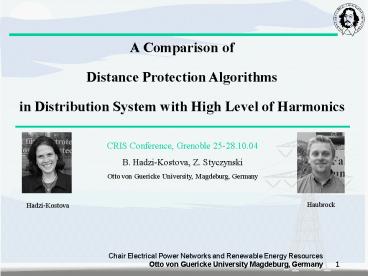Algorithmen PowerPoint PPT Presentation
1 / 21
Title: Algorithmen
1
A Comparison of Distance Protection Algorithms
in Distribution System with High Level of
Harmonics
CRIS Conference, Grenoble 25-28.10.04 B.
Hadzi-Kostova, Z. Styczynski Otto von Guericke
University, Magdeburg, Germany
Haubrock
Hadzi-Kostova
2
Presentation Outline
3
Motivation
- Implemetation of DER on power system
- Protection device may see in case of a fault no
typical - fault current and no fault current duration
- (raising implemetation of power electronic
devices on the - network DER, Loads.)
4
General
- Protection system Unity of all devices to
fullfill the task - of protection in EES.
- Protecting network elements and devices from
damages - Keeping the EES in its functional unity.
Characteristics Selectivity (protection zone),
speed, sensitivity (no over- and underfunction),
reliability (reserve protection).
- Types and usage
- Overcurrent (motors, lines, reserve protection)
- Distance (lines, reserve for transformers)
- Differential (short lines, transformers).
5
Methods for calculation of impedance
Clasical methods
New methods
6
Modeling of Test Network in MATLAB
7
Modeling of Harmonics in MATLAB
The European Norms EN 61000 - 3 - 2
8
1) Steady-State algorithms - characteristics
- few sampling data (8-12)
- small data window
- very fast (5 ms)
- good results by clear sinusoidal signals
- sensitive on phase shift
- very sensitive on presence of harmonics.
Example Algorithmus of Rockefeller needs four
sampling data of voltage and current to
calculates the impedance
9
1) Testing of Steady State Algorithms
1) Typical responce of steady state Algorithms
(Rockefeller)
10
2) Algorithms using DEFO - Characteristics
- sampling data (8-24)
- small data window
- fast (10-15 ms)
- good results by clear sinusoidal signals
- not sensitive on phase shift
- relatively sensitive on presence of harmonics.
Example Algorithm of Lobos A3 Metode
11
2) Testing of DEFO Algorithms
2) Typical responce of DEFO -Algorithms
12
3) Testing of DESO Algorithm
3) Typical responce of DESO-Algorithm
13
4) Filter Algorithms Characteristics
- sampling data (20)
- data window (20)
- relatively slow (20 ms)
- good results by clear sinusoidal signals
- not sensitive on phase shift
- not sensitive on presence of harmonics.
Example Algorithm of Phadke/ Ibrahim
14
4) Testing of Filter - Algorithms
4) Typical responce of Filter -Algorithms
15
4) Testing of Filter - Algorithms
4) Typical responce of Filter -Algorithms
16
5) Parameter estimation with LSQ procedure
Calculation fault
17
5) Parameter estimation - Results
18
5) Calculation of the impedance of the faulted
line
19
6) HANN Differences between LSQ and BP procedures
By training
By calculation of impedance
Xa
Ra
Za
20
Conclusions
- Lot of algorithms (all without filter (1-3)) are
influenced - of the presence of harmonics
- Different algorithms characterise themselves
with different - responce in the mentioned criteria
- Parameter Estimation (5) and HANN (6) show new
possibilities - for usage in network protection. Problem are the
unknown - networks and the training times.
21
Thank You for Your Attention!

